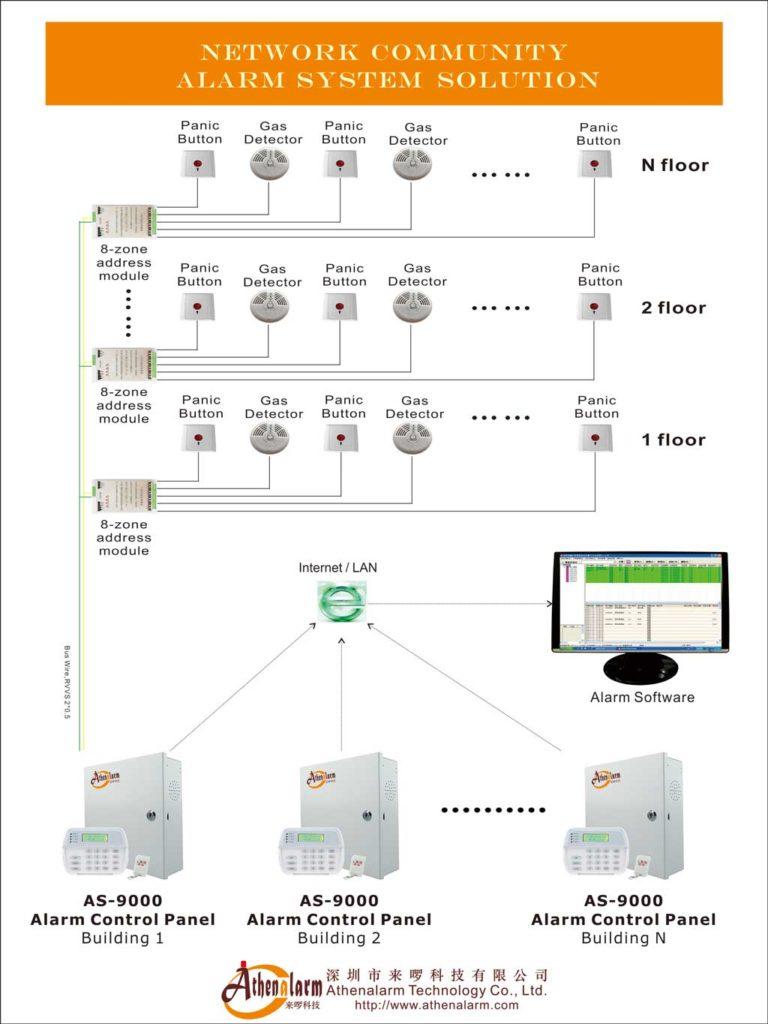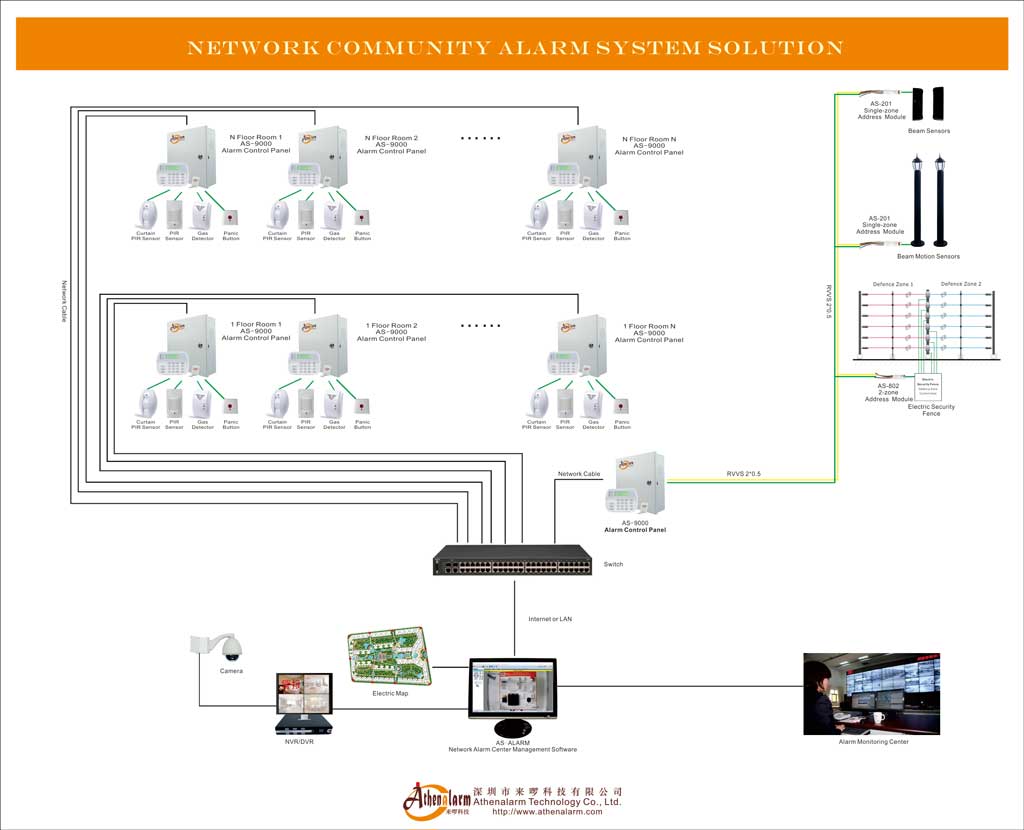



Network Community Alarm System Solution

Table of Contents
ToggleProject Background
As the economy continues to grow and living standards improve, people are increasingly prioritizing the safety of their homes and property. This has led to the adoption of various measures to ensure family security.
Traditional protective methods, such as residential walls and anti-theft fences, not only compromise the aesthetic appeal of communities but also fail to effectively deter criminal activities. Previous solutions, like installing anti-theft doors and window bars, provide limited protection while creating other issues. They often violate fire safety standards, making escape difficult during emergencies such as fires or earthquakes. Additionally, these solutions are not entirely effective in preventing intrusions.
As a result, modernizing and integrating intelligent security measures in residential communities has become essential. Protecting residents’ property from theft and robbery is now a pressing concern for families. The implementation of a Community Alarm system has become increasingly important in addressing these challenges.
Most families today consist of dual-income earners, leaving homes unoccupied during the day. In the event of an alarm, timely and effective responses are critical to minimizing potential criminal activity. This necessitates the establishment of an alarm monitoring center with dedicated personnel to manage and respond to alerts.
Market Demand
To ensure the safety of residents’ lives and property and provide peace of mind, it is essential to deploy an advanced burglar alarm system. This system includes an alarm monitoring center housed within the community’s management office. When a resident’s alarm is triggered, the system not only activates an on-site alert but also notifies the local police or security bureau. This networked alarm system facilitates swift and efficient responses.
The burglar alarm system employs various devices, such as passive infrared sensors, door contacts, perimeter infrared sensors, and panic buttons, to protect residents comprehensively. When activated, these detectors monitor for unauthorized activities such as break-ins, glass breakage, door tampering, or fence climbing. Any abnormal activity triggers a sound and light alarm, alerting residents and on-duty guards while transmitting signals to the alarm monitoring center. The system also integrates with the closed-circuit television (CCTV) monitoring system, enabling real-time recording of events.
The integration of the electronic burglar alarm system with the CCTV monitoring system ensures unified management and seamless operation. In case of an emergency, the CCTV system automatically records the scene in real-time, providing essential evidence to identify the cause of the incident.
Project Requirements
Terminal Requirements
Each household in the community must be equipped with security devices offering both burglar alarm and emergency assistance functions:
- Burglar Alarm Function: When a house is unoccupied, the system must immediately send alarm notifications to the network monitoring center in case of unauthorized entry.
- Emergency Assistance Function: In situations involving threats, harassment, or robbery, family members can use the system to request emergency help. The system must alert the network monitoring center and notify designated contacts, such as family members, neighbors, or friends, for immediate assistance.
Platform Requirements
The network alarm monitoring center must feature a computerized management platform capable of:
- Receiving alarm information through telephone lines or TCP/IP networks.
- Displaying real-time video of alarm scenes.
- Automatically showing detailed alarm information, including the specific area, building, and household affected, enabling security personnel to respond promptly.
Key Features:
- Practicality: Ensure effective protection for every household in the community.
- Ease of Use: The system must be user-friendly, with minimal operational steps and straightforward functionality.
- Systematic Approach: In addition to alerting community security, alarms must also notify local public security authorities.
- Reliability: The system should have a robust design, be easy to maintain, and feature durable products with minimal false alarms or missed detections.
- Cost-Effectiveness: The system should be affordable for residents, ensuring widespread adoption.
- Ease of Installation: Installation must involve simple wiring and construction while maintaining system stability and reliability.
By meeting these requirements, the burglar alarm system will provide a secure, user-friendly, and reliable solution for modern residential communities.
Composition of the Total Community Security System
The community security system consists of five major components:
Perimeter Protection Alarm System
This system prevents unauthorized individuals from climbing walls and entering the community. It utilizes sensing cables, electric security fences, or active infrared beam sensors to provide a robust first line of defense.
Monitoring System
Designed to manage and monitor vehicles, personnel, and key facilities entering and exiting the community’s main areas. This system works in conjunction with the community alarm system and the perimeter protection system to record on-site activities, enhancing alarm response efficiency.
Security Patrol Management System
This system allows security personnel to supervise suspicious activities and individuals within the community. It integrates with an electronic patrol management system to ensure security patrols are completed effectively, maintaining strict residential property management.
Network Visual Intercom System
This system restricts unauthorized access to elevators, preventing outsiders from loitering around the community.
Network Alarm System
The most critical and final layer of the security system. It addresses emergencies such as break-ins, gas leaks, fires, or medical situations. Electronic detectors installed indoors automatically trigger alarms. Alarm information is sent to the monitoring center, which dispatches security or rescue personnel promptly.
Community Alarm System Solution
Composition of the Network Alarm System
(1) Network Alarm Monitoring Center:
This serves as the core alarm monitoring center, often located within the community property security department.
(2) Terminal Alarm Control Panel:
Installed in each residence, this panel functions as a control hub for burglar alarms, emergency help, fire prevention, and more.
The solution employs the Athenalarm AS-ALARM Network Alarm Center Management Software. The AS-9000 Alarm Control Panel connects to front-end equipment (e.g., alarm devices and linkage modules) and communicates with a unified backend database. This system supports multiple communication protocols, including RS485, TCP/IP, GPRS, GSM, and PSTN, enabling seamless resource sharing and coordination via the integrated management platform.
- Partitioning and Control: The AS-9000 control panel allows for defense zone partitioning. When an alarm signal is detected, it is sent to the monitoring center, triggering an audible alarm to alert on-duty staff. Security personnel can assess the situation through intercom systems and dispatch responders to the scene promptly.
- Alarm Linkage: When a device, such as an infrared detector, triggers an alarm, the control panel signals the AS-ALARM system to record the event and activate corresponding warning lights. Security staff can view the location of the intrusion on monitoring screens and respond immediately.
Front-end protection systems can also include beam sensors and electric security fences for enhanced perimeter security.
Design Concepts
(1) Residential Unit Setup:
- Install an alarm control panel in each residential unit or commercial shop.
- Residents can opt for additional devices, such as door contacts, panic buttons, smoke detectors, and gas detectors.
- Alarm notifications are transmitted via telephone lines or TCP/IP networks to the central monitoring center.
The system offers remote alarm functionality and optional parallel printing. In emergencies like break-ins, gas leaks, or fires, the system triggers audible and visual alarms. The monitoring center promptly displays the alarm type, location, and user details, enabling security personnel to respond efficiently. Residents can also activate emergency calls directly to the monitoring center in case of robbery or medical emergencies.
The monitoring system supports real-time video feeds, providing immediate situational awareness to responders.
(2) Centralized Alarm Monitoring Centers:
- Establish a primary alarm monitoring center in the community’s security office.
- Create additional centers at local police stations or other relevant locations.
The AS-ALARM alarm software can forward alarm information to higher-level centers, such as public security bureaus. Multi-level monitoring ensures swift responses to emergencies while reducing strain on local resources.
System Design Goals
The goal is to maintain round-the-clock protection for residents by continuously monitoring and detecting threats. In case of an alarm, the system:
- Identifies and displays the household’s information (e.g., name, address, and alarm type).
- Alerts security personnel for prompt verification and response.
- Enables residents to directly contact the monitoring center for emergencies.
The system’s design ensures intuitive user interfaces, robust monitoring capabilities, and effective management of incidents.
Selection of Alarm Equipment
- AS-9000 Alarm Control Panel
- AS-ALARM Network Alarm Center Management Software
- Sensors (e.g., motion detectors, smoke detectors, gas detectors)
For detailed specifications, refer to the Athenalarm Burglar Alarms product documentation.
Advantages of the Community Alarm System
(1) Scalability:
Each alarm control panel supports up to 200 programmable defense zones. Sensors are bus-connected, simplifying system expansion without extensive re-wiring.
(2) Ease of Use:
The system is user-friendly, with simple operation requirements. High-power sirens deter intruders effectively while providing clear alerts to security personnel. Zones can be managed flexibly using bypass designs, enabling easy arming and disarming of specific areas.
(3) Reliable Construction:
The bus-based alarm system features simple wiring and minimal cable usage, resulting in higher stability and lower error rates. It covers a broader area compared to traditional systems, making it cost-effective for larger installations.
(4) Simplified Maintenance:
The system isolates faults within specific zones, preventing them from affecting the overall system. Fault indicators provide clear notifications, enabling quick repairs or replacements.
With these advantages, the Community Alarm System ensures reliable, cost-effective, and comprehensive protection for residential communities, safeguarding both property and lives.
Summary
The Network Community Alarm System Solution offers an advanced and reliable alarm system designed to enhance community safety. This solution integrates cutting-edge technology to provide a centralized and efficient alarm management system for residential and community spaces. It ensures real-time monitoring, quick response to emergencies, and seamless communication across the network.
This system is ideal for modern communities seeking an efficient, scalable, and dependable security solution.
Ready to Enhance Your Community’s Security?
Protect your residents, property, and peace of mind with our advanced community alarm solutions. Whether you’re building a new community or upgrading an existing one, we’re here to help you every step of the way.
Contact us today to learn more about our customized security solutions and how we can support your safety needs. Don’t wait—click Contact Us now and let us help you create a safer, smarter community.

